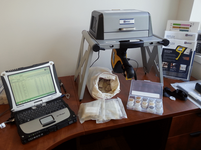pacog
Jr. Member
- Apr 23, 2013
- 29
- 8
- Detector(s) used
- Gold Bug Pro
- Primary Interest:
- Prospecting
Hey guys I recently had a XRF analysis done on some Black sands and I am wondering about some of the readings I got back.
It list's the several minerals that were in the samples and what they would yield per ton. That's the easy part to understand.
My question comes because there is a long list of elements that are listed as NON DETECTED. The person who ran the test told me, these elements were detected but in very small qtys, that were just barely readable by the XRF machine. The problem is these elements have Higher Numbers( I assume they are PPM results) listed next to them than some of the Elements that were listed in OZ per Ton section So I am confused because the person who conducted the test said that these tested very low, but the numbers listed are very high. I would assume 1-40ppm would be very low
So I am confused because the person who conducted the test said that these tested very low, but the numbers listed are very high. I would assume 1-40ppm would be very low
I am still waiting to hear back from the Testing Facility to see if those numbers that are listed for the NON Detected are the PPM of each element.
It list's the several minerals that were in the samples and what they would yield per ton. That's the easy part to understand.
My question comes because there is a long list of elements that are listed as NON DETECTED. The person who ran the test told me, these elements were detected but in very small qtys, that were just barely readable by the XRF machine. The problem is these elements have Higher Numbers( I assume they are PPM results) listed next to them than some of the Elements that were listed in OZ per Ton section
 So I am confused because the person who conducted the test said that these tested very low, but the numbers listed are very high. I would assume 1-40ppm would be very low
So I am confused because the person who conducted the test said that these tested very low, but the numbers listed are very high. I would assume 1-40ppm would be very low
I am still waiting to hear back from the Testing Facility to see if those numbers that are listed for the NON Detected are the PPM of each element.









